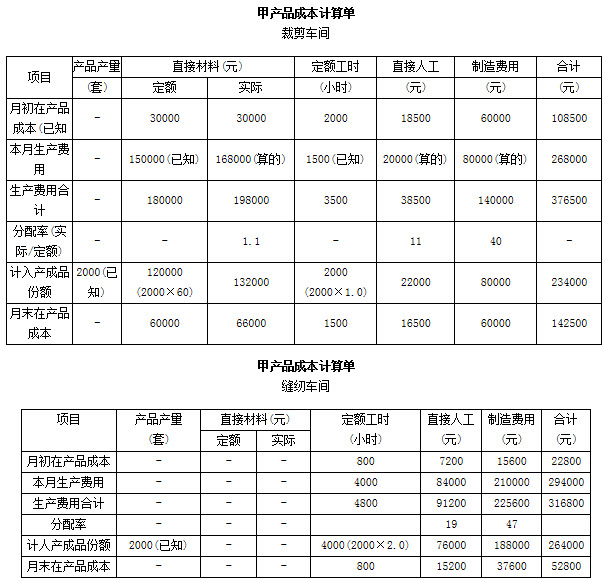F公司是一个服装生产企业,常年大批量生产甲、乙两种工作服。产品生产过程划分为裁剪、缝纫两个步骤,相应设置裁剪、缝纫两个车间。裁剪车间为缝纫车间提供半成品,经缝纫车间加工最终形成产成品。甲、乙两种产品耗用主要材料(布料)相同,且在生产开始时一次投入。所耗辅助材料(缝纫线和扣子等)由于金额较小,不单独核算材料成本,而直接计入制造费用。
F公司采用平行结转分步法计算产品成本。实际发生生产费用在各种产品之间的分配方法是:材料费用按定额材料费用比例分配;生产工人薪酬和制造费用按实际生产工时分配。月末完工产品与在产品之间生产费用的分配方法是:材料费用按定额材料费用比例分配;生产工人薪酬和制造费用按定额工时比例分配。F公司8月份有关成本计算资料如下:
(1)甲、乙两种产品定额资料:

(2)8月份甲产品实际完工入库产成品2000套。
(3)8月份裁剪车间、缝纫车间实际发生的原材料费用、生产工时数量以及生产工人薪酬、制造费用如下:

(4)裁剪车间和缝纫车间甲产品的期初在产品成本如下:

要求:
编制裁剪车间和缝纫车间的甲产品成本计算单,结果填入答题卷给定的“甲产品成本计算单”中。
参考答案:
[提示] 月末完工产品与在产品之间生产费用的分配方法是:材料费用按定额材料费用(月初在产品30000元,本月投入150000元)比例分配;生产工人薪酬和制造费用按定额工时(2000+1500,800+4000)比例分配。

注意:在平行结转分步法中的产品指的是最终完工入库的产品(本题中指的是2000件),在各个车间的成本计算单以及成本汇总计算表中数量是完全一致的。
